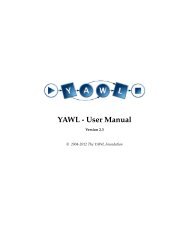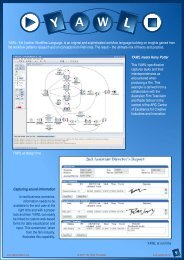Semantics, Verification, and Implementation of Workflows ... - YAWL
Semantics, Verification, and Implementation of Workflows ... - YAWL
Semantics, Verification, and Implementation of Workflows ... - YAWL
You also want an ePaper? Increase the reach of your titles
YUMPU automatically turns print PDFs into web optimized ePapers that Google loves.
Chapter 2. Formal foundations<br />
Definition 2.31 (Irreducible cancellation regions) Let N be an e<strong>YAWL</strong>-net.<br />
N satisfies the irreducible cancellation regions property iff for all x ∈ ran (rem),<br />
x is not a reducible cancellation element w.r.t some task t in dom (rem) 9 .<br />
An OR-join task is said to be convertible, when it could be better represented<br />
as either an XOR-join or an AND-join task. Such tasks arise in two circumstances:<br />
(i) when it is never possible to reach a marking which marks more than one<br />
input condition <strong>of</strong> the task <strong>and</strong> (ii) when all input conditions <strong>of</strong> the task are<br />
marked in all markings that enables the OR-join task. The objective is to detect<br />
unnecessary OR-join tasks at design time as the non-local semantics <strong>of</strong> OR-join<br />
requires expensive runtime analysis. This can be detected by looking at markings<br />
in the reachability set that enable an OR-join task. In Figure 2.12, OR-join task<br />
D is only enabled when all input conditions are marked (due to an AND-split task<br />
A) <strong>and</strong> therefore, D should be modelled as an AND-join instead <strong>of</strong> an OR-join.<br />
Definition 2.32 (Convertible OR-join) Let N be an e<strong>YAWL</strong>-net <strong>and</strong> t be an<br />
OR-join task in N. OR-join task t can be modelled as<br />
• an XOR-join if only one condition in •t is ever marked in the enabling<br />
markings <strong>of</strong> t, i.e., ∀ M∈N[Mi 〉(M[t〉 =⇒ ∃! p∈•t (M(p) > 0)),<br />
• an AND-join if for all conditions in •t are always marked in the enabling<br />
markings <strong>of</strong> t, i.e., ∀ M∈N[Mi 〉(M[t〉 =⇒ ∀ p∈•t (M(p) > 0)) 10 .<br />
Figure 2.12: A <strong>YAWL</strong> net with a (convertible) OR-join task D<br />
Definition 2.33 (Immutable OR-joins) Let N be an e<strong>YAWL</strong>-net. N satisfies<br />
the immutable OR-joins property iff for all t ∈ T , join(t) = OR implies that t is<br />
not a convertible OR-join.<br />
In this section, formal definitions for a <strong>YAWL</strong> net <strong>and</strong> four structural properties<br />
have been presented. In the next section, the mappings from <strong>YAWL</strong> to reset<br />
nets are demonstrated.<br />
9 dom means the domain <strong>of</strong> a function <strong>and</strong> ran means the range <strong>of</strong> a function<br />
10 We are using here the reset net notation <strong>of</strong> reachable markings for <strong>YAWL</strong>. The formal<br />
semantics <strong>of</strong> the OR-join is defined in Chapter 3.<br />
PhD Thesis – c○ 2006 M.T.K Wynn – Page 27





